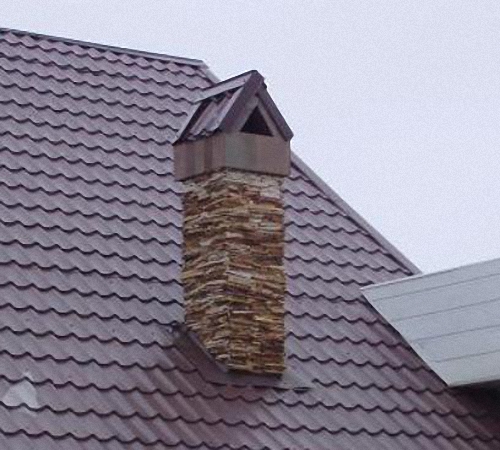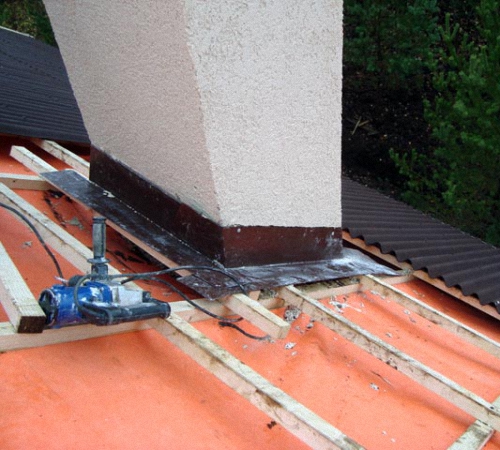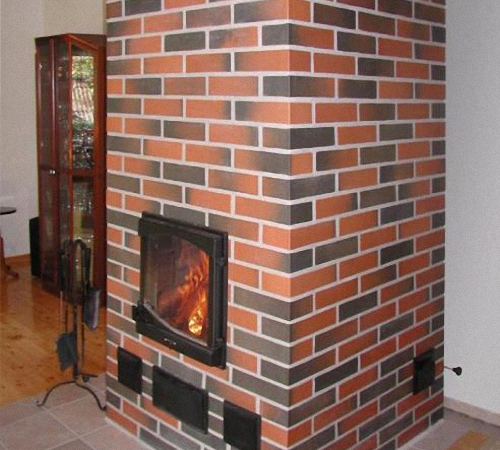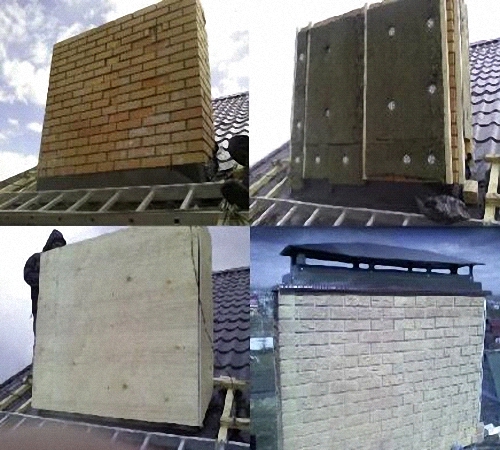The German brand for the production of windows Rehau (Rehau) holds leadership positions ...
|
|
Clinker tiles - ideal for wall decoration. This is explained primarily ... |
The ceiling plinth performs not only a decorative function, visually separating the walls ... |
How to finish the chimney on the roof and inside the house

When arranging a chimney, the question inevitably arises of how to cover the outgoing pipe. The difference in temperature, the impact of the external environment and weather conditions - all this affects the durability of the chimney service. An important part of the system is its decorativeness. Beautiful cladding will raise the level of aesthetic perception of the roof and give it a complete look.
Breeding:
- Selection of materials for finishing
- What rules and norms should you adhere
- Stages of finishing the pipe on the roof
- Hermetization of pipes
- Suspication
- Pipe lining
- Decorating the chimney inside the house: Selection of material
- Advantages and disadvantages of materials for cladding
Selection of materials for finishing
Initially, when choosing a material for finishing the chimney, it is necessary to take into account its protective capabilities. Of the negative factors that reduce the service life of the chimney - the following are distinguished:
- the impact of the weather,
- temperature difference during the year,
- high operating temperature,
- ultraviolet radiation.

The main problem is the difference between high working and external atmospheric temperature. Because of this, condensation is formed in the chimney, which enters the structure and gradually destroys it. Good insulation of the chimney using facing materials can significantly reduce the formation of condensate. In addition, it is important to ensure the correspondence of facing materials in relation to the roof roof. The material used should differ in a high degree of resistance to atmospheric phenomena and wear resistance.
The finish of the chimney is performed using such materials:
- decorative brick,
- tile,
- cement slabs,
- roofing material,
- ready -made solutions.
The finish of the chimney pipe with decorative brick is the most practical option. The clinker brick is especially good in this regard. It is not noticeable in the course of operation and it goes well with any type of roof. Clinker tiles are characterized by high mechanical strength and resistance to atmospheric influences and more often it is used to facing high thin pipes. For a powerful chimney design, a full -colored brick is used, staggered in a checkerboard pattern on a special adhesive.
Plaster is more often used for decorative finishes. Thanks to its versatility and affordable value, this method of decoration is often used. The process of applying the material is similar to the decoration of the facade walls, while the choice in the direction of mineral or acrylic varieties will significantly increase the service life.
Cement slabs are good in that they have a low weight and various variations of the texture, so that with their help it is quite possible to recreate any surface. At the same time, the material is environmentally friendly and non -comb.
Under roofing material, corrugated board is more often used. It is a profiled metal sheet made by IL steel by cold rental. The corrugated board is interesting in that it has a low price to supplement to high protective properties and its durability and at the same time quite decorative. Metal structures do not have a large weight and are easily mounted, while providing an attractive aesthetic appearance.

An original solution is the use of finished designs. More often these are rubber products that provide heat and waterproofing. A wide protective apron will protect the chimney from moisture and dirt into the roofing pie, but at the same time it is not a good design element. It is more suitable for external chimney pipes made of stainless steel.
What rules and norms should you adhere
Before making cladding, it is important to pay attention to the compliance of the finished structure with the NNUP standards. Requirements for heating and ventilation provide for the following points:
- the insulation of hot surfaces provides for the laying of thermal insulation capable of ensuring the difference in temperature on the surface of the cladding and the inside up to 20C,
- pipelines and ducts should be made from materials that have a protective anti -corrosion coating. Or of those that themselves are characterized by corrosion resistance,
- the free space between the pipes and the roof must be covered with non -combustible roofing materials,
- the use of asbestos materials is not allowed,
- if the furnace is heated by coal, then in this case it is impossible to install pipes for the chimney made of stainless steel,
- the mouth of the chimney should not interfere with the free exit of smoke from the chimney,
- the thickness of chimney pipes made of clay brick should be less than 120 mm, from heat -resistant concrete - 60 mm.

Stages of finishing the pipe on the roof
- The facing finish begins with the installation of a special protective apron at the site of the chimney to the roof. The apron is laid in two layers: one is started under the roof, the second layer of the protective apron is laid on top of the coating. The adjoining places are thoroughly sealed.
- Additional pipe finishing is required in such cases:
- insufficient thrust in the chimney,
- ensuring decorating the chimney elements out of the roof,
- facing the chimney pipe was made of simple brick, which does not have the proper degree of aesthetics,
- the materials used for the chimney do not correspond to the style of the house, standing out of the general view,
Hermetization of pipes
The finish of the chimney on the roof primarily begins from ensuring the proper degree of sealing the output of the pipe. Relatively recently, the norms were prescribed to build advanced brickwork at the pipe exit site. This was required in order to perform roofing material in order to seal the joint. Ultimately, the design received a rather bulky look and was unattractive from an aesthetic point of view. Modern materials allow you to avoid such requirements and at the same time ensure effective sealing. Any roofing material must be wrapped in a chimney laying. Next, a protective apron is installed around the pipe. The apron itself is often made of galvanized metal 2-4 mm thick, but it requires a polymer coating for resistance against atmospheric exposure. For aprons, non -combustible materials are always used that can withstand the effects of high temperatures.

The most optimal option for ensuring high -quality sealing is a combination of a flexible tape for sealing and a metal apron with a polymer coating. The tape is made of aluminum foil with the addition of bituminous and polymeric materials as a self -adhesive layer. It is laid under the apron, at the site of the chimney to the roof. After laying the apron, a transparent silicone sealant is applied to the seams, which completes sealant.
Suspication
The decoration of a brick chimney often requires additional suturing. As a rule, it is required in such cases:
- brick masonry is made of simple brick,
- with a large height of the pipe, which is more than two meters above the surface of the roof, a weak traction is provided,
- aesthetic tastes.
In addition, if the ducts have a light plastic base, then often in brickwork there is no need. In this case, the sheathing simply closes the frame through which such communications pass.
Before making a lining of the output of the chimney, it is necessary to build a frame around the pipe. The frame is assembled either from metal profiles or a wooden beam with a thickness of not more than 5x5 cm. It should be taken into account that the wood should be pre -treated with an antiseptic to protect the tree from the effects of climatic conditions. Many modern antiseptics are able to give it protection from parasites and weather when processing wood, and in addition to this increase fire resistance. Nevertheless, wood is a controversial solution, since with a significant temperature difference, condensate is formed, which absorbs the tree well.

As a material for the frame, a profile of the same thickness and texture that is used for drywall is often used. At the same time, all compounds are made using metal dowels.
The chimney suturing with sheet metal is one of the most practical ways. The costs of the complexity and price of the material are minimal, the installation is quite simple. When ensuring proper thermal insulation, the surface of the skin will not be prone to severe heating, which will allow it to be covered with rubber paint to ensure additional protection against exposure to ultraviolet and weather metal. Also, the color will give the design additional aesthetics.
Pipe lining
A beautiful decoration of a brick chimney often implies a lining of pipes with a decorative stone of artificial or natural origin. In this case, it is required to clarify the pipes with high -quality decorative bricks and ensure the strength of fasteners with reliable connecting materials. Otherwise, when exposed to temperatures, the cladding may break off the pipe. But at the same time it is worth remembering that high -quality decorative brick and so has the proper degree of aesthetics. Often he does not need additional cladding, since he does not violate the integrity of the chosen composition. If the cladding elements have a significant weight, then in this case they will require additional strengthening. In addition to the adhesive composition along the edges of the tiles, a hardware or dowel fastener is often used.

Decorating the chimney inside the house: Selection of material
In a country house, a fireplace or stove is more often built in the living room. The chimney often passes through ceiling floors and often through all rooms. In this case, there is a need to harmoniously fit the protruding parts into the interior.
- First, a frame of a metal profile is built, which is then covered with drywall sheets. The usual material is not suitable for this, so you need a fire -resistant plasterboard sheet that wears the designation of GCL.
- Inside the frame to ensure thermal insulation, mineral or glass -wolf wool is invested. Thanks to this material, the surface of the sheet is ready for finishing with any material, including even simple worshiping on the sheet.
- The finish of the chimney inside the house does not require special costs. For example, ceramic tiles or gypsum stucco molding will be perfectly combined with many interior styles. It is advisable to perform some elements in the form of a mosaic, especially its combinations of glass of different colors.
The most durable and durable material for decoration, both internal and external, is clinker brick. It is well suited for interiors made in a minimalist style, while often it does not require additional decoration.

The plaster is more often used for interior decoration for simplicity and antiquity. This is the oldest way that has still preserved many adherents.
The choice of decoration method is more dependent on taste preferences, since the proper thermal insulation of the chimney will allow external finishes by any material.
Advantages and disadvantages of materials for cladding
The market offers a huge number of different decoration materials. In order not to be confused in this assortment, it is important to know their distinctive species, as well as qualities:
- Sidings are plastic panels for outdoor decoration. They are installed on the chimney if high -quality thermal insulation was provided. The material requires installation on a rigid base, not toxic and is not afraid of water. In this case, it melts when exposed to flame or high temperature and is characterized by low strength and frost resistance.
- The plaster is distinguished by its durability and resistance to atmospheric conditions, but at the same time, labor consumption is enough in laying and characterized by high cost. Also, applying plaster often implies the subsequent layer of decorative style or painting.

- Clinker brick is valued for its strength and durability. At the same time, its decorative properties are also on top. From its shortcomings, a high price is allocated: from 1000 rubles per 1 m2, and its weight. Often the design of the chimney in this case will require additional amplification.
- Ceramic tiles are suitable exclusively for interior decoration. It is mounted on even and flat surfaces, and at the same time it is demanding on preliminary preparatory work. The tile is characterized by its aesthetics and low price.
- The corrugated board is one of the best materials for decoration of the roof and chimney. The material is characterized by lightweight, resistance to loads and the influence of the weather. At the same time, manufacturers offer an extensive color scheme. Of the minuses of corrugated board, its weak sound insulation is distinguished.
- The metal tile is good for its simplicity of installation and durability. The finishing of the chimney with a metal profile will provide the aesthetics of the structure and its resistance to climate. Like corrugated board, the metal tile is not able to provide good sound insulation. In principle, this is not so important when decorating a chimney.

What the hell? Any roofing
What the hell? "Any roofing material must be wrapped in a chimney laying." Firstly, they wrap not roofing, but in a baking material, and secondly, as I understand it, not anyone. Bitumen materials with a chimney are not compatible, it is necessary to use non -combustible materials. Not?